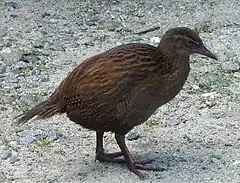| Gallirallus[1] | |||
| Lafresnaye, 1841[2] | |||
 Przedstawiciel rodzaju – weka (G. australis) | |||
| Systematyka | |||
| Domena | |||
|---|---|---|---|
| Królestwo | |||
| Typ | |||
| Podtyp | |||
| Gromada | |||
| Infragromada | |||
| Rząd | |||
| Nadrodzina | |||
| Rodzina | |||
| Rodzaj |
Gallirallus | ||
| Typ nomenklatoryczny | |||
|
Gallirallus brachypterus Lafresnaye, 1841 (= Rallus australis Sparrman, 1786) | |||
| Synonimy | |||
|
| |||
| Gatunki | |||
| |||
Gallirallus – rodzaj ptaków z rodziny chruścieli (Rallidae).
Zasięg występowania
Rodzaj obejmuje gatunki występujące na Nowej Kaledonii, Nowej Zelandii i Filipinach[6][7].
Morfologia
Długość ciała 45–60 cm, rozpiętość skrzydeł 50–60 cm; masa ciała samców 532–1605 g, samic 350–1035 g;[6].
Systematyka
Etymologia
- Ocydromus: gr. ωκυς ōkus „hyży, szybki”; -δρομος -dromos „biegacz”, od τρεχω trekhō „biegać”[8]. Gatunek typowy: Rallus troglodytis Wagler, 1830 (= Rallus australis Sparrman, 1786); młodszy homonim Ocydromus Schellenberg, 1806 (Coleoptera).
- Gallirallus: zbitka wyrazowa nazw rodzajów: Gallus Brisson, 1760 (kur) oraz Rallus Linnaeus, 1758 (wodnik)[9].
- Brachypteryx: gr. βραχυς brakhus „krótki”; πτερυξ pterux, πτερυγος pterugos „skrzydło” (por. βραχυπτερος brakhupteros „krótkoskrzydły”, od βραχυς brakhus „krótki”; πτερον pteron „skrzydło”)[10]. Gatunek typowy: Rallus australis Sparrman, 1786; młodszy homonim Brachypteryx Horsfield, 1821 (Muscicapidae).
- Tricholimnas: gr. θριξ thrix, τριχος trikhos „włosy”; nowołac. limnas „wodnik”, od gr. λιμνας limnas „z bagna”, od λιμνη limnē „bagno, mokradło”[11]. Gatunek typowy: Gallirallus lafresnayanus J. Verreaux & Des Murs, 1860.
Podział systematyczny
Do rodzaju należą następujące gatunki[12]:
- Gallirallus lafresnayanus J. Verreaux, & Des Murs, 1860 – wodnik nowokaledoński
- Gallirallus australis (Sparrman, 1786) – weka
Przypisy
- ↑ Gallirallus, [w:] Integrated Taxonomic Information System (ang.).
- ↑ F. de Lafresnaye. Nouvelles espèces d’oiseaux décrites. „Revue Zoologie”, s. 234, 1841. (fr.).
- ↑ J.G. Wagler: Natürliches System der Amphibien, mit vorangehender Classification der Säugethiere und Vögel. Ein Beitrag zur vergleichenden Zoologie. München, Stuttgart und Tübingen: In der J.G. Cotta’scchen Buchhandlung, 1830, s. 98. (niem.).
- ↑ R. Owen. On the remains of the gigantic and presumed extinct Wingless or Terrestrial Birds of New Zealand (Dinornis and Palapteryx), with indications of two other genera (Notornis and Nestor). „Proceedings of the Zoological Society of London”. 16, s. 2, 7, 1848. (ang.).
- ↑ R.B. Sharpe. On the Classification of the Rallidæ. „Bulletin of the British Ornithologists’ Club”. 1 (5), s. xxviii, 1893. (ang.).
- 1 2 P.B. Taylor: Family Rallidae (Rails, Gallinules and Coots). W: J. del Hoyo, A. Elliott & J. Sargatal: Handbook of the Birds of the World. Cz. 3: Hoatzin to Auks. Barcelona: Lynx Edicions, 1996, s. 161–162. ISBN 84-87334-20-2. (ang.).
- ↑ F. Gill, D. Donsker & P. Rasmussen (red.): Finfoots, flufftails, rails, trumpeters, cranes, Limpkin. IOC World Bird List (v11.1). [dostęp 2021-04-05]. (ang.).
- ↑ Jobling 2021 ↓, s. Ocydromus.
- ↑ Jobling 2021 ↓, s. Gallirallus.
- ↑ Jobling 2021 ↓, s. Brachypteryx.
- ↑ Jobling 2021 ↓, s. Tricholimnas.
- ↑ Systematyka i nazwy polskie za: P. Mielczarek, M. Kuziemko: Rodzina: Rallidae Rafinesque, 1815 - chruściele - Rails and Coots (wersja: 2021-11-03). [w:] Kompletna lista ptaków świata [on-line]. Instytut Nauk o Środowisku Uniwersytetu Jagiellońskiego. [dostęp 2021-11-05].
Bibliografia
- James A. Jobling: The Key to Scientific Names. [w:] Birds of the World [on-line]. Cornell Laboratory of Ornithology, Ithaca, NY, USA, 2021. (ang.).
Identyfikatory zewnętrzne:
This article is issued from Wikipedia. The text is licensed under Creative Commons - Attribution - Sharealike. Additional terms may apply for the media files.